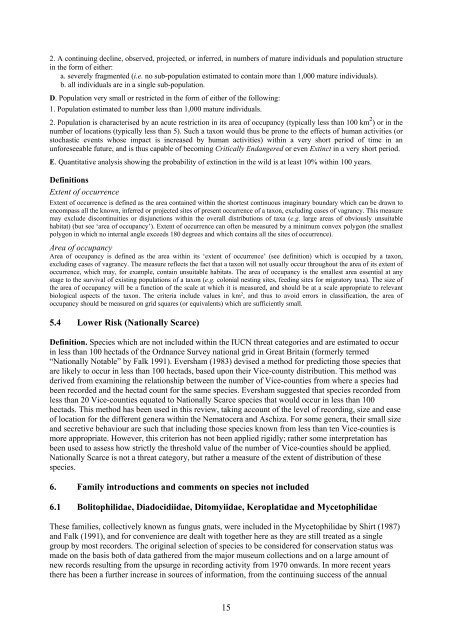Part 2: Nematocera and Aschiza not dealt with by Falk (1991) - JNCC
Part 2: Nematocera and Aschiza not dealt with by Falk (1991) - JNCC
Part 2: Nematocera and Aschiza not dealt with by Falk (1991) - JNCC
Create successful ePaper yourself
Turn your PDF publications into a flip-book with our unique Google optimized e-Paper software.
2. A continuing decline, observed, projected, or inferred, in numbers of mature individuals <strong>and</strong> population structure<br />
in the form of either:<br />
a. severely fragmented (i.e. no sub-population estimated to contain more than 1,000 mature individuals).<br />
b. all individuals are in a single sub-population.<br />
D. Population very small or restricted in the form of either of the following:<br />
1. Population estimated to number less than 1,000 mature individuals.<br />
2. Population is characterised <strong>by</strong> an acute restriction in its area of occupancy (typically less than 100 km 2 ) or in the<br />
number of locations (typically less than 5). Such a taxon would thus be prone to the effects of human activities (or<br />
stochastic events whose impact is increased <strong>by</strong> human activities) <strong>with</strong>in a very short period of time in an<br />
unforeseeable future, <strong>and</strong> is thus capable of becoming Critically Endangered or even Extinct in a very short period.<br />
E. Quantitative analysis showing the probability of extinction in the wild is at least 10% <strong>with</strong>in 100 years.<br />
Definitions<br />
Extent of occurrence<br />
Extent of occurrence is defined as the area contained <strong>with</strong>in the shortest continuous imaginary boundary which can be drawn to<br />
encompass all the known, inferred or projected sites of present occurrence of a taxon, excluding cases of vagrancy. This measure<br />
may exclude discontinuities or disjunctions <strong>with</strong>in the overall distributions of taxa (e.g. large areas of obviously unsuitable<br />
habitat) (but see ‘area of occupancy’). Extent of occurrence can often be measured <strong>by</strong> a minimum convex polygon (the smallest<br />
polygon in which no internal angle exceeds 180 degrees <strong>and</strong> which contains all the sites of occurrence).<br />
Area of occupancy<br />
Area of occupancy is defined as the area <strong>with</strong>in its ‘extent of occurrence’ (see definition) which is occupied <strong>by</strong> a taxon,<br />
excluding cases of vagrancy. The measure reflects the fact that a taxon will <strong>not</strong> usually occur throughout the area of its extent of<br />
occurrence, which may, for example, contain unsuitable habitats. The area of occupancy is the smallest area essential at any<br />
stage to the survival of existing populations of a taxon (e.g. colonial nesting sites, feeding sites for migratory taxa). The size of<br />
the area of occupancy will be a function of the scale at which it is measured, <strong>and</strong> should be at a scale appropriate to relevant<br />
biological aspects of the taxon. The criteria include values in km 2 , <strong>and</strong> thus to avoid errors in classification, the area of<br />
occupancy should be measured on grid squares (or equivalents) which are sufficiently small.<br />
5.4 Lower Risk (Nationally Scarce)<br />
Definition. Species which are <strong>not</strong> included <strong>with</strong>in the IUCN threat categories <strong>and</strong> are estimated to occur<br />
in less than 100 hectads of the Ordnance Survey national grid in Great Britain (formerly termed<br />
“Nationally Notable” <strong>by</strong> <strong>Falk</strong> <strong>1991</strong>). Eversham (1983) devised a method for predicting those species that<br />
are likely to occur in less than 100 hectads, based upon their Vice-county distribution. This method was<br />
derived from examining the relationship between the number of Vice-counties from where a species had<br />
been recorded <strong>and</strong> the hectad count for the same species. Eversham suggested that species recorded from<br />
less than 20 Vice-counties equated to Nationally Scarce species that would occur in less than 100<br />
hectads. This method has been used in this review, taking account of the level of recording, size <strong>and</strong> ease<br />
of location for the different genera <strong>with</strong>in the <strong>Nematocera</strong> <strong>and</strong> <strong>Aschiza</strong>. For some genera, their small size<br />
<strong>and</strong> secretive behaviour are such that including those species known from less than ten Vice-counties is<br />
more appropriate. However, this criterion has <strong>not</strong> been applied rigidly; rather some interpretation has<br />
been used to assess how strictly the threshold value of the number of Vice-counties should be applied.<br />
Nationally Scarce is <strong>not</strong> a threat category, but rather a measure of the extent of distribution of these<br />
species.<br />
6. Family introductions <strong>and</strong> comments on species <strong>not</strong> included<br />
6.1 Bolitophilidae, Diadocidiidae, Ditomyiidae, Keroplatidae <strong>and</strong> Mycetophilidae<br />
These families, collectively known as fungus gnats, were included in the Mycetophilidae <strong>by</strong> Shirt (1987)<br />
<strong>and</strong> <strong>Falk</strong> (<strong>1991</strong>), <strong>and</strong> for convenience are <strong>dealt</strong> <strong>with</strong> together here as they are still treated as a single<br />
group <strong>by</strong> most recorders. The original selection of species to be considered for conservation status was<br />
made on the basis both of data gathered from the major museum collections <strong>and</strong> on a large amount of<br />
new records resulting from the upsurge in recording activity from 1970 onwards. In more recent years<br />
there has been a further increase in sources of information, from the continuing success of the annual<br />
15
















